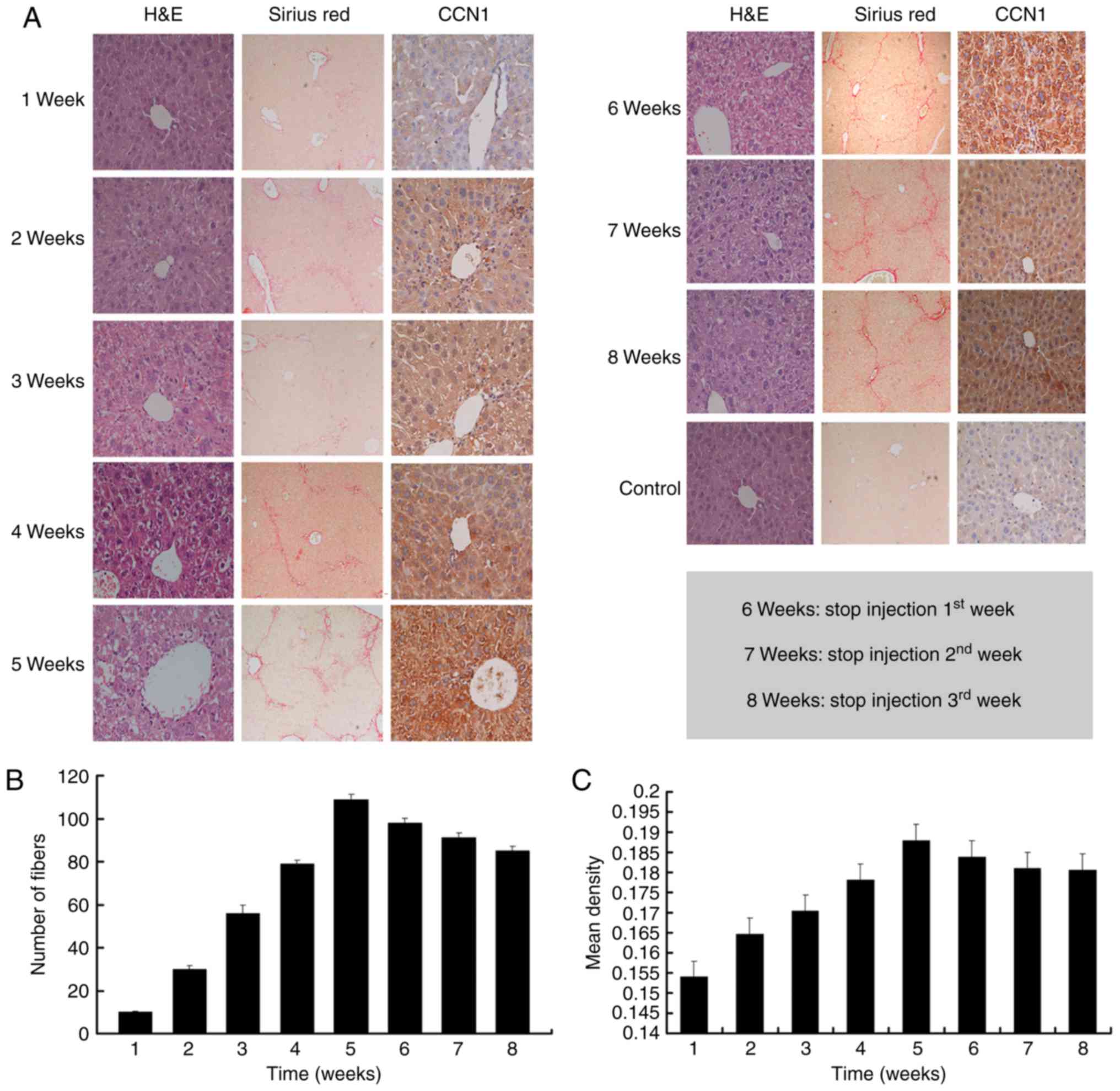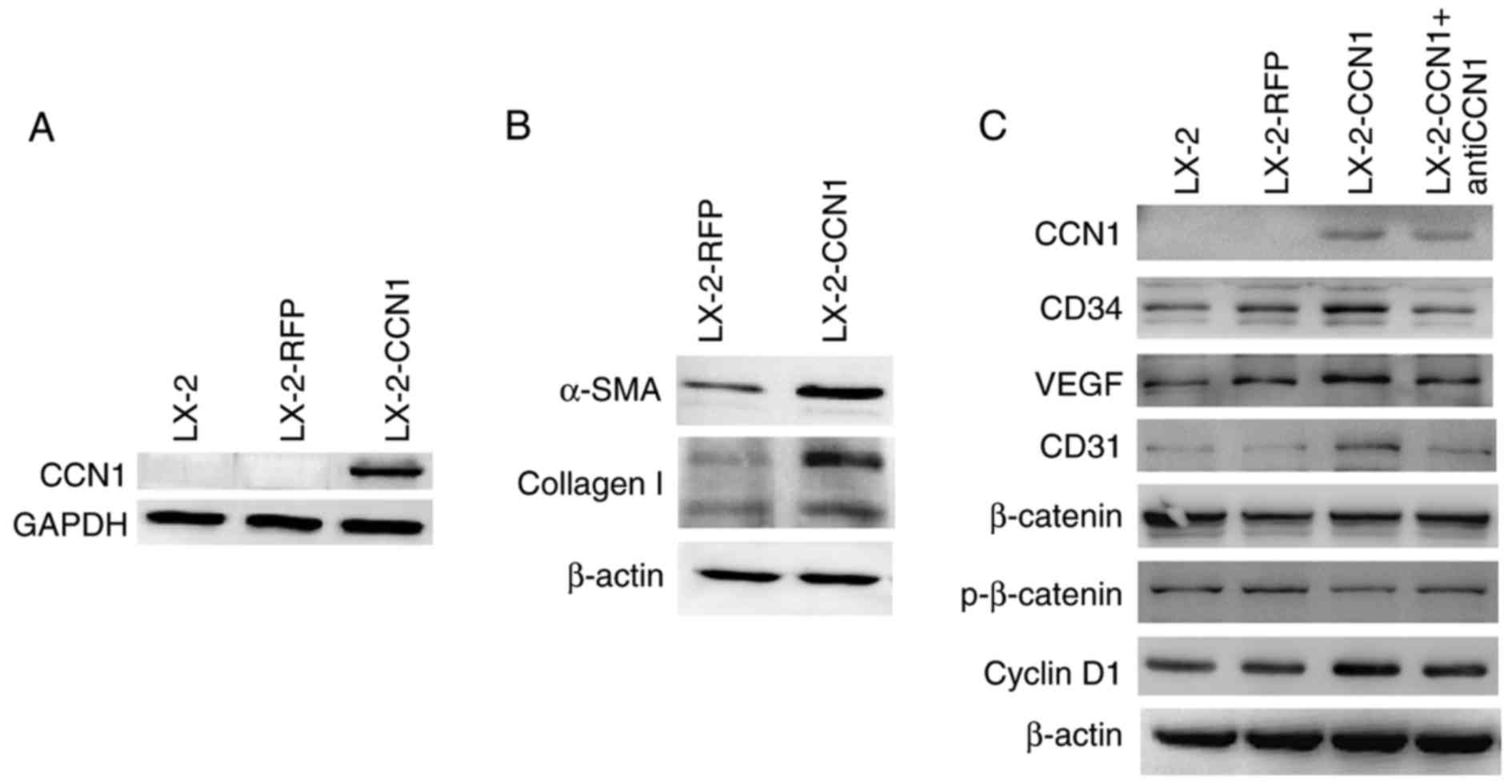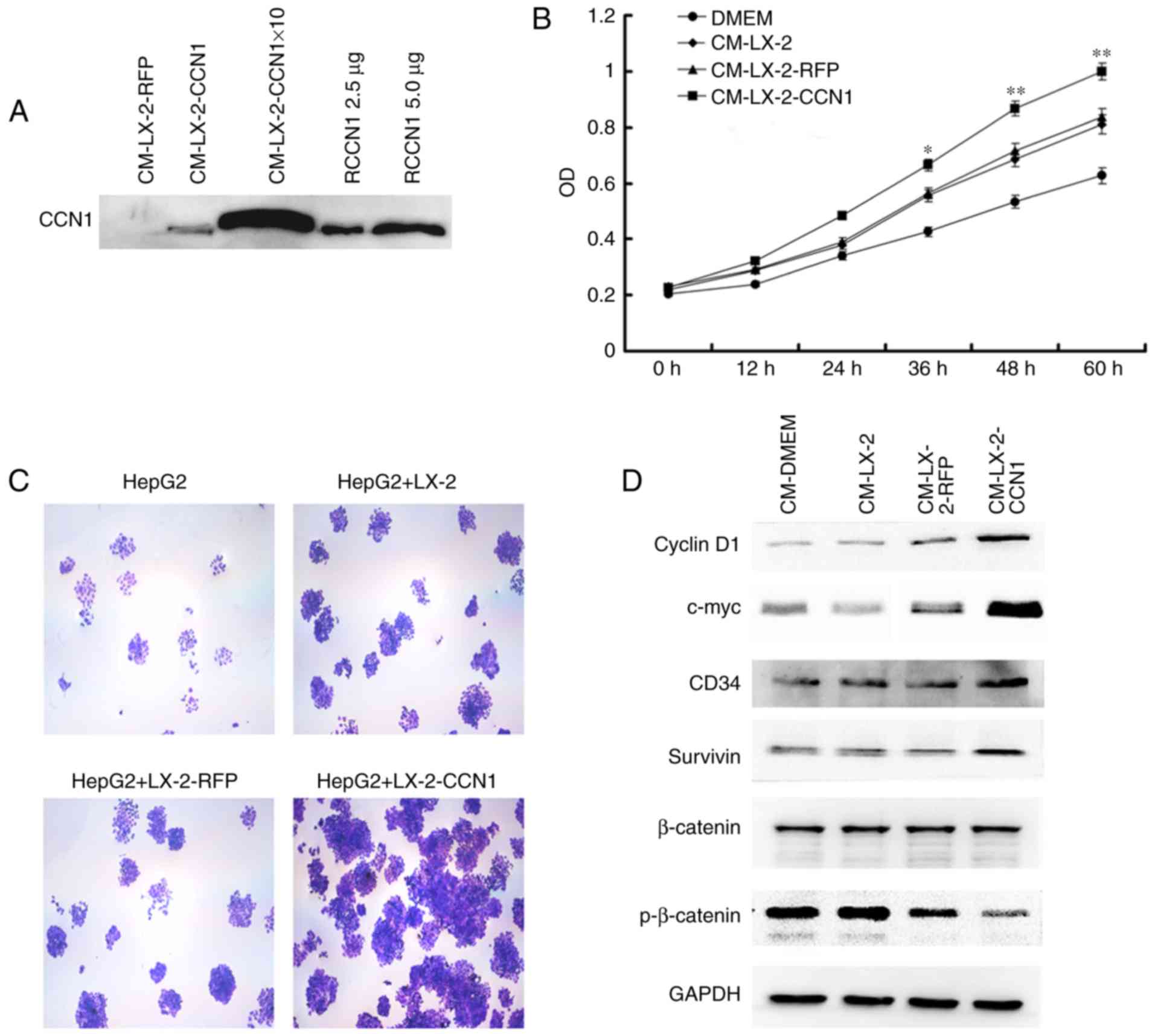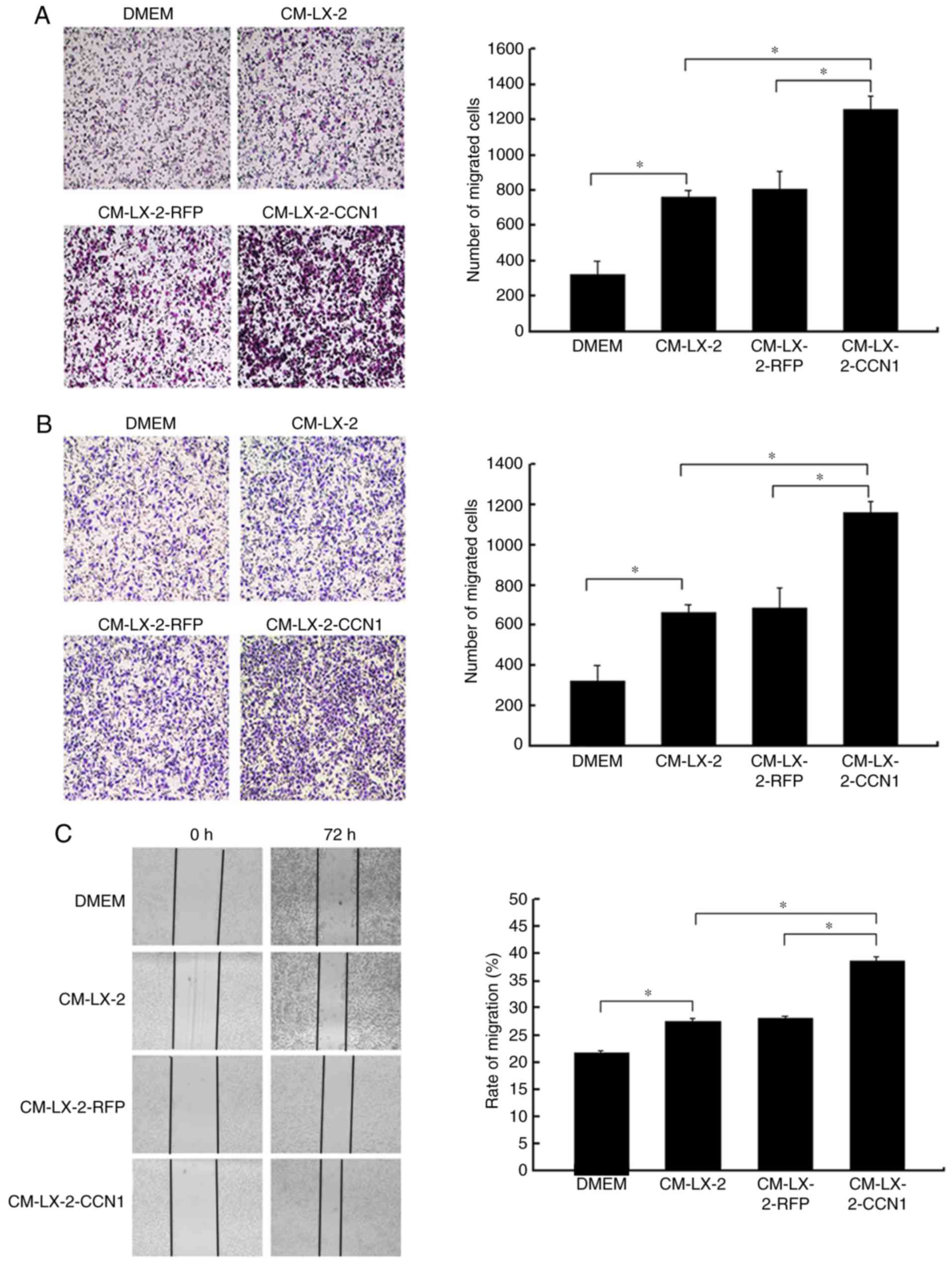|
1
|
Song P, Tang W, Tamura S, Hasegawa K,
Sugawara Y, Dong J and Kokudo N: The management of hepatocellular
carcinoma in Asia: A guideline combining quantitative and
qualitative evaluation. Biosci Trends. 4:283–287. 2010.
|
|
2
|
Chen W, Zheng R, Baade PD, Zhang S, Zeng
H, Bray F, Jemal A, Yu XQ and He J: Cancer statistics in China,
2015. CA Cancer J Clin. 66:115–132. 2016. View Article : Google Scholar : PubMed/NCBI
|
|
3
|
Schütte K, Bornschein J and Malfertheiner
P: Hepatocellular carcinoma-epidemiological trends and risk
factors. Dig Dis. 27:80–92. 2009. View Article : Google Scholar
|
|
4
|
Bataller R and Brenner DA: Liver fibrosis.
J Clin Invest. 115:209–218. 2005. View
Article : Google Scholar : PubMed/NCBI
|
|
5
|
Li JT, Liao ZX, Ping J, Xu D and Wang H:
Molecular mechanism of hepatic stellate cell activation and
antifibrotic therapeutic strategies. J Gastroenterol. 43:419–428.
2008. View Article : Google Scholar : PubMed/NCBI
|
|
6
|
Lau LF: CCN1/CYR61: The very model of a
modern matricellular protein. Cell Mol Life Sci. 68:3149–3163.
2011. View Article : Google Scholar : PubMed/NCBI
|
|
7
|
Schmitz P, Gerber U, Jüngel E, Schütze N,
Blaheta R and Bendas G: Cyr61/CCN1 affects the integrin-mediated
migration of prostate cancer cells (PC-3) in vitro. Int J Clin
Pharmacol Ther. 51:47–50. 2013. View
Article : Google Scholar
|
|
8
|
Haseley A, Boone S, Wojton J, Yu L, Yoo
JY, Yu J, Kurozumi K, Glorioso JC, Caligiuri MA and Kaur B:
Extracellular matrix protein CCN1 limits oncolytic efficacy in
glioma. Cancer Res. 72:1353–1362. 2012. View Article : Google Scholar : PubMed/NCBI
|
|
9
|
Jun JI, Kim KH and Lau LF: The
matricellular protein CCN1 mediates neutrophil efferocytosis in
cutaneous wound healing. Nat Commun. 6:73862015. View Article : Google Scholar : PubMed/NCBI
|
|
10
|
Chintala H, Krupska I, Yan L, Lau L, Grant
M and Chaqour B: The matricellular protein CCN1 controls retinal
angiogenesis by targeting VEGF, Src homology 2 domain phosphatase-1
and Notch signaling. Development. 142:2364–2374. 2015. View Article : Google Scholar : PubMed/NCBI
|
|
11
|
Zhang F, Hao F, An D, Zeng L, Wang Y, Xu X
and Cui MZ: The matricellular protein Cyr61 is a key mediator of
platelet-derived growth factor-induced cell migration. J Biol Chem.
290:8232–8242. 2015. View Article : Google Scholar : PubMed/NCBI
|
|
12
|
Jun JI and Lau LF: Taking aim at the
extracellular matrix: CCN proteins as emerging therapeutic targets.
Nat Rev Drug Discov. 10:945–963. 2011. View
Article : Google Scholar : PubMed/NCBI
|
|
13
|
Grzeszkiewicz TM, Kirschling DJ, Chen N
and Lau LF: CYR61 stimulates human skin fibroblast migration
through integrin alpha vbeta 5 and enhances mitogenesis through
integrin alpha vbeta 3, independent of its carboxyl-terminal
domain. J Biol Chem. 276:21943–21950. 2001. View Article : Google Scholar : PubMed/NCBI
|
|
14
|
Chen N, Chen CC and Lau LF: Adhesion of
human skin fibroblasts to Cyr61 is mediated through integrin alpha
6beta 1 and cell surface heparan sulfate proteoglycans. J Biol
Chem. 275:24953–24961. 2000. View Article : Google Scholar : PubMed/NCBI
|
|
15
|
Li ZQ, Ding W, Sun SJ, Li J, Pan J, Zhao
C, Wu WR and Si WK: Cyr61/CCN1 is regulated by Wnt/β-catenin
signaling and plays an important role in the progression of
hepatocellular carcinoma. PLoS One. 7:e357542012. View Article : Google Scholar
|
|
16
|
Rashid ST, Humphries JD, Byron A, Dhar A,
Askari JA, Selley JN, Knight D, Goldin RD, Thursz M and Humphries
MJ: Proteomic analysis of extracellular matrix from the hepatic
stellate cell line LX-2 identifies CYR61 and Wnt-5a as novel
constituents of fibrotic liver. J Proteome Res. 11:4052–4064. 2012.
View Article : Google Scholar : PubMed/NCBI
|
|
17
|
Bian Z, Peng Y, You Z, Wang Q, Miao Q, Liu
Y, Han X, Qiu D, Li Z and Ma X: CCN1 expression in hepatocytes
contributes to macrophage infiltration in nonalcoholic fatty liver
disease in mice. J Lipid Res. 54:44–54. 2013. View Article : Google Scholar :
|
|
18
|
Borkham-Kamphorst E, Schaffrath C, Van de
Leur E, Haas U, Tihaa L, Meurer SK, Nevzorova YA, Liedtke C and
Weiskirchen R: The anti-fibrotic effects of CCN1/CYR61 in primary
portal myofibroblasts are mediated through induction of reactive
oxygen species resulting in cellular senescence, apoptosis and
attenuated TGF-β signaling. Biochim Biophys Acta. 1843:902–914.
2014. View Article : Google Scholar : PubMed/NCBI
|
|
19
|
Borkham-Kamphorst E, Steffen BT, Van de
Leur E, Haas U, Tihaa L, Friedman SL and Weiskirchen R: CCN1/CYR61
overexpression in hepatic stellate cells induces ER stress-related
apoptosis. Cell Signal. 28:34–42. 2016. View Article : Google Scholar
|
|
20
|
Kim KH, Chen CC, Monzon RI and Lau LF:
Matricellular protein CCN1 promotes regression of liver fibrosis
through induction of cellular senescence in hepatic myofibroblasts.
Mol Cell Biol. 33:2078–2090. 2013. View Article : Google Scholar : PubMed/NCBI
|
|
21
|
Kim KH, Chen CC, Alpini G and Lau LF: CCN1
induces hepatic ductular reaction through integrin αvβ(5)-mediated
activation of NF-κB. J Clin Invest. 125:1886–1900. 2015. View Article : Google Scholar : PubMed/NCBI
|
|
22
|
Chen CC, Kim KH and Lau LF: The
matricellular protein CCN1 suppresses hepatocarcinogenesis by
inhibiting compensatory proliferation. Oncogene. 35:1314–1323.
2016. View Article : Google Scholar
|
|
23
|
Huang G and Brigstock DR: Integrin
expression and function in the response of primary culture hepatic
stellate cells to connective tissue growth factor (CCN2). J Cell
Mol Med. 15:1087–1095. 2011. View Article : Google Scholar
|
|
24
|
Patsenker E, Popov Y, Wiesner M, Goodman
SL and Schuppan D: Pharmacological inhibition of the vitronectin
receptor abrogates PDGF-BB-induced hepatic stellate cell migration
and activation in vitro. J Hepatol. 46:878–887. 2007. View Article : Google Scholar : PubMed/NCBI
|
|
25
|
Zhou X, Murphy FR, Gehdu N, Zhang J,
Iredale JP and Benyon RC: Engagement of alphavbeta3 integrin
regulates proliferation and apoptosis of hepatic stellate cells. J
Biol Chem. 279:23996–24006. 2004. View Article : Google Scholar : PubMed/NCBI
|
|
26
|
Ju MJ, Qiu SJ, Fan J, Xiao YS, Gao Q, Zhou
J, Li YW and Tang ZY: Peritumoral activated hepatic stellate cells
predict poor clinical outcome in hepatocellular carcinoma after
curative resection. Am J Clin Pathol. 131:498–510. 2009. View Article : Google Scholar : PubMed/NCBI
|
|
27
|
Mikula M, Proell V, Fischer AN and
Mikulits W: Activated hepatic stellate cells induce tumor
progression of neoplastic hepatocytes in a TGF-beta dependent
fashion. J Cell Physiol. 209:560–567. 2006. View Article : Google Scholar : PubMed/NCBI
|
|
28
|
Zhao W, Zhang L, Yin Z, Su W, Ren G, Zhou
C, You J, Fan J and Wang X: Activated hepatic stellate cells
promote hepatocellular carcinoma development in immunocompetent
mice. Int J Cancer. 129:2651–2661. 2011. View Article : Google Scholar : PubMed/NCBI
|
|
29
|
Santamato A, Fransvea E, Dituri F,
Caligiuri A, Quaranta M, Niimi T, Pinzani M, Antonaci S and
Giannelli G: Hepatic stellate cells stimulate HCC cell migration
via laminin-5 production. Clin Sci (Lond). 121:159–168. 2011.
View Article : Google Scholar
|
|
30
|
Amann T, Bataille F, Spruss T, Mühlbauer
M, Gäbele E, Schölmerich J, Kiefer P, Bosserhoff AK and Hellerbrand
C: Activated hepatic stellate cells promote tumorigenicity of
hepatocellular carcinoma. Cancer Sci. 100:646–653. 2009. View Article : Google Scholar : PubMed/NCBI
|
|
31
|
Sancho-Bru P, Juez E, Moreno M, Khurdayan
V, Morales-Ruiz M, Colmenero J, Arroyo V, Brenner DA, Ginès P and
Bataller R: Hepatocarcinoma cells stimulate the growth, migration
and expression of pro-angiogenic genes in human hepatic stellate
cells. Liver Int. 30:31–41. 2010. View Article : Google Scholar
|
|
32
|
Coulouarn C, Corlu A, Glaise D, Guénon I,
Thorgeirsson SS and Clément B: Hepatocyte-stellate cell cross-talk
in the liver engenders a permissive inflammatory microenvironment
that drives progression in hepatocellular carcinoma. Cancer Res.
72:2533–2542. 2012. View Article : Google Scholar : PubMed/NCBI
|
|
33
|
Jandova J, Beyer TE, Meuillet EJ and Watts
GS: The matrix protein CCN1/CYR61 is required for α(V)β(5)-mediated
cancer cell migration. Cell Biochem Funct. 30:687–695. 2012.
View Article : Google Scholar : PubMed/NCBI
|
|
34
|
Jun JI and Lau LF: The matricellular
protein CCN1 induces fibroblast senescence and restricts fibrosis
in cutaneous wound healing. Nat Cell Biol. 12:676–685. 2010.
View Article : Google Scholar : PubMed/NCBI
|
|
35
|
Zhang DY and Friedman SL:
Fibrosis-dependent mechanisms of hepatocarcinogenesis. Hepatology.
56:769–775. 2012. View Article : Google Scholar : PubMed/NCBI
|
|
36
|
Nejak-Bowen KN and Monga SP: Beta-catenin
signaling, liver regeneration and hepatocellular cancer: Sorting
the good from the bad. Semin Cancer Biol. 21:44–58. 2011.
View Article : Google Scholar :
|
|
37
|
Monga SP: Role of Wnt/β-catenin signaling
in liver metabolism and cancer. Int J Biochem Cell Biol.
43:1021–1029. 2011. View Article : Google Scholar
|
|
38
|
Awuah PK and Monga SP: Cell cycle-related
kinase links androgen receptor and β-catenin signaling in
hepatocellular carcinoma: Why are men at a loss. Hepatology.
55:970–973. 2012. View Article : Google Scholar : PubMed/NCBI
|
|
39
|
Liu Z, Guo Y, Li J, Xu J and Liu B:
Cotransfection of survivin and CD44v3 short hairpin RNAs affects
proliferation, apoptosis, and invasiveness of colorectal cancer.
Dig Dis Sci. 58:1590–1601. 2013. View Article : Google Scholar : PubMed/NCBI
|
|
40
|
Chen L, Liang L, Yan X, Liu N, Gong L, Pan
S, Lin F, Zhang Q, Zhao H and Zheng F: Survivin status affects
prognosis and chemosensitivity in epithelial ovarian cancer. Int J
Gynecol Cancer. 23:256–263. 2013. View Article : Google Scholar : PubMed/NCBI
|
|
41
|
Jia YL, Shi L, Zhou JN, Fu CJ, Chen L,
Yuan HF, Wang YF, Yan XL, Xu YC, Zeng Q, et al: Epimorphin promotes
human hepatocellular carcinoma invasion and metastasis through
activation of focal adhesion kinase/extracellular signal-regulated
kinase/matrix metalloproteinase-9 axis. Hepatology. 54:1808–1818.
2011. View Article : Google Scholar : PubMed/NCBI
|














